Recent News
- In-situ Al–5ZrB2 composite foams : Comparable alternative for conventional Al foams October 7, 2022
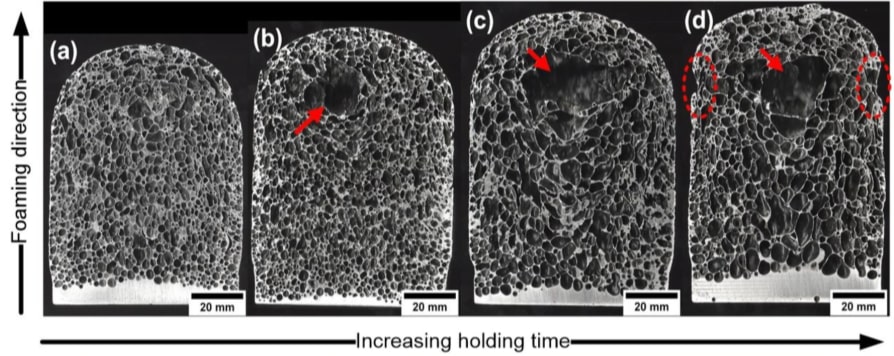
Closed-cell metal foams are crucial to heavy industry machinery as they primarily function as impact-absorbing materials. Stabilizing closed-cell metal foams is a pivotal element in the process of manufacturing closed-cell metal foams. On this note, Prof GS Vinod Kumar from The Department of Mechanical Engineering has published a paper entitled Production, stability, and properties of in-situ Al–5ZrB2 composite foams in the journal Materials Science and Engineering: A with an impact factor of 6.044.
Abstract
Stabilization is an essential requirement to produce closed-cell metal foams. In the melt route of foaming, usually ceramic particles are used as foam stabilizers. For the first time, the present study introduces ZrB2 particles as foam stabilizers. We demonstrate the foaming of in-situ based Al composite containing submicron ZrB2 particles. The effect of foaming temperature and holding time on the structural and mechanical properties of the foams was studied. The composites and foams were characterized using XRD, SEM/EDS, and optical scanning techniques. The mechanical properties of the foams were determined by subjecting the foams to a quasi-static compression test. Submicron ZrB2 particles present in the cell wall and at the gas-solid interface promoted foam stability. All the foams exhibited a good cellular structure with high expansion. Among the foams, the foams prepared at 680 ºC with a holding time of 120 s exhibited the smallest cell size and the best mechanical properties. The structural and mechanical properties of the Al–5ZrB2 foams were found to be comparable to conventional foams.
Novel in-situ ZrB2 particles were produced to form Al-5ZrB2 composites. ZrB2 particles present in the melt tend to stabilize the H2 gas bubbles produced from the decomposition of TiH2. The macrostructure was best observed when foamed at 680 ºC and held for 120 sec. Because of its finer pores ( ̴ 3mm ), excellent compressive strength and energy absorption capacity was exhibited comparable to conventional Al foams.
The paper observes a wide-range of possibilities for the application of in-situ Al–5ZrB2 composite foams to modify bullet proof vests, car body parts, sound and heat proof walls in theatres, naval ship bodies, etc.
Prof Vinod Kumar also discusses the future application of this technique in use of metallic powders as blending agent for effective dispersion of blowing agent in the melt and in the field of compressive and energy absorption studies for Al composite foams.
Continue reading → - Two paper publications from Prof G S Vinod Kumar and his scholar September 29, 2022
A robust body of published works helps advance research capabilities and contribute to the larger research domain. Two latest paper publications from the Department of Mechanical Engineering are co-authored by Prof G S Vinod Kumar and his PhD student, Mr Akshay Devikar.
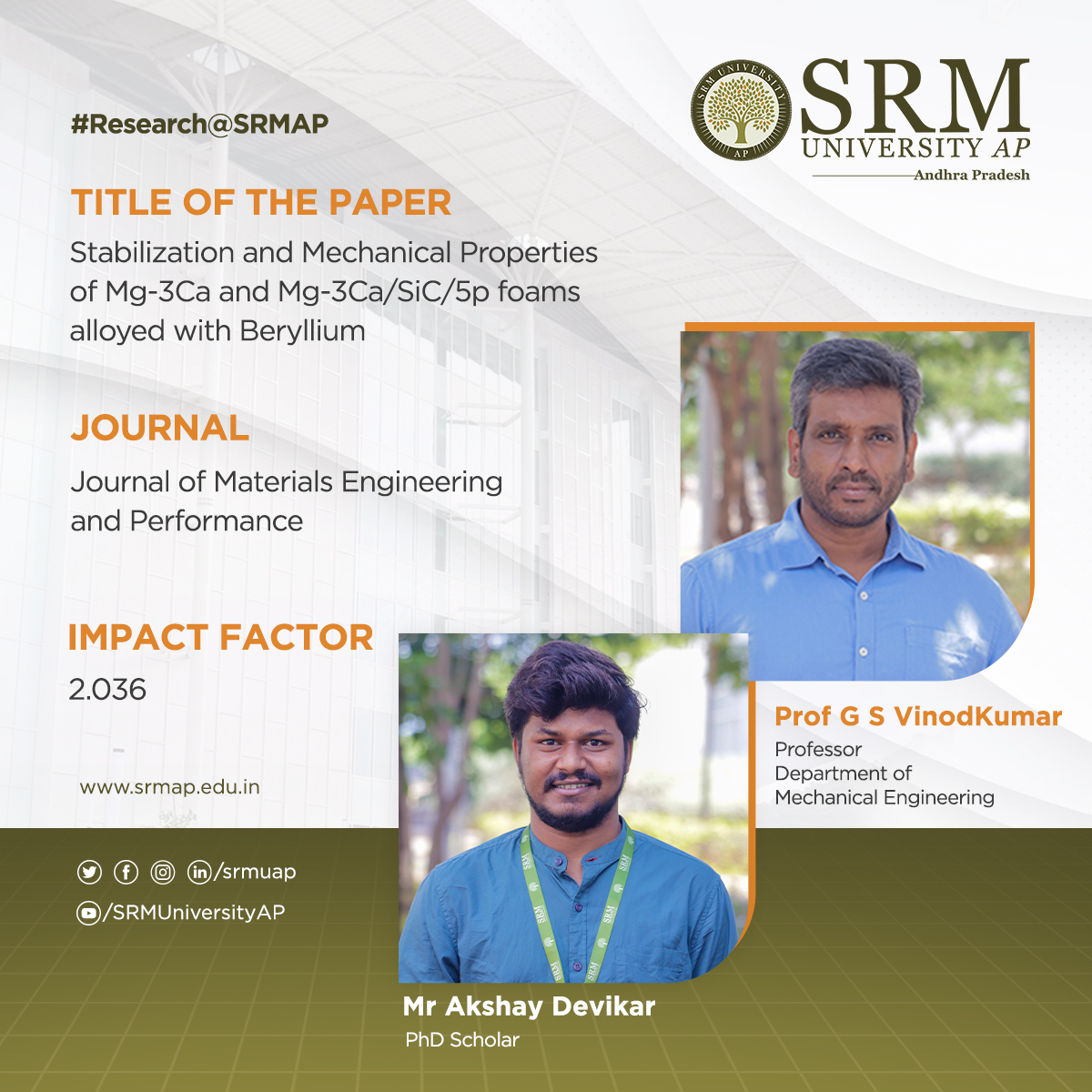 The first paper, Stabilization and Mechanical Properties of Mg-3Ca and Mg-3Ca/SiC/5p foams alloyed with Beryllium, got published in the Journal of Materials Engineering and Performance and had an impact factor of 2.036.
The first paper, Stabilization and Mechanical Properties of Mg-3Ca and Mg-3Ca/SiC/5p foams alloyed with Beryllium, got published in the Journal of Materials Engineering and Performance and had an impact factor of 2.036.Liquid processing of Magnesium is complicated due to its uncontrolled flammability in the presence of oxygen. However, owing to the lightweight property of Mg, it can be used as a structural material in various sectors such as naval, aerospace, automobile, biomedical, heat exchangers, and military applications. Therefore, using Ca and Be as alloying elements and oxidation preventers, the researchers produced lightweight Mg foams (of density 0.17 g/cm 3), which float on water. SiC particles provide excellent Mg foam stabilisation as well. The compression tests revealed the highest strength for Mg-3Ca foam containing both Be and SiC. Thus, the burning problem of Mg was overcome by adding Ca and a trace quantity of Be to make lightweight foams, which were strengthened by SiC particles.
Abstract
The present paper investigates the stabilisation of Mg-3Ca alloy and Mg-3Ca/SiC/5p composite foams with and without the addition of 0.12 wt.% beryllium. In Mg-3Ca alloy foam, Be addition has significantly improved the expansion and pore structure. Whereas, in the case of Mg-3Ca/SiC/5p composite foams, the SiC particles stabilised the foam effectively, while Be addition did not show any distinguishable improvement in the foam structure. The formation of BeO and the dense coverage of SiC particles in the gas-solid interface of Mg-3Ca and Mg-3Ca/SiC/5p composite foams, respectively, are the reasons for the foam stabilization. Mg-3Ca/SiC/5p composite foam exhibited the lowest foam density of 0.10 g/cm3. The quasi-static compression test shows that Mg-3Ca-0.12Be/SiC/5p composite foam containing Be exhibited lower foam density and higher normalized compressive strength. The energy absorption capacity per unit foam density in Be containing foams was also higher.
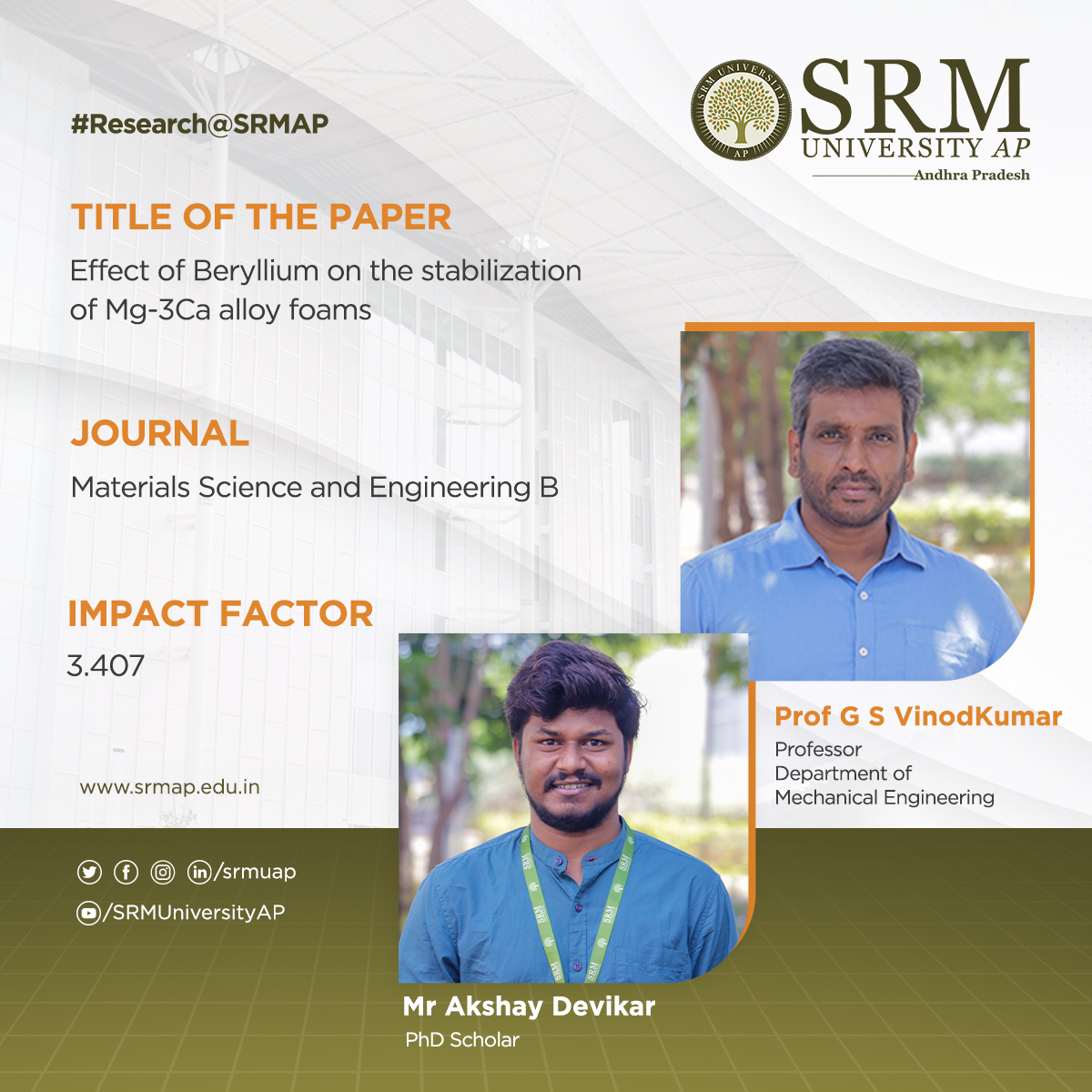 The second paper, the Effect of Beryllium on the stabilization of Mg-3Ca alloy foams, is published in the journal Materials Science and Engineering B with an impact factor of 3.407.
The second paper, the Effect of Beryllium on the stabilization of Mg-3Ca alloy foams, is published in the journal Materials Science and Engineering B with an impact factor of 3.407.Mg-3Ca alloy foams of density as low as 0.25 g/cm3 were successfully produced via the liquid metal route in an open-air atmosphere with trace Be addition. The stable BeO layer formed at the gas-solid interfaces of pores restricted the Mg + CO2/CO reaction, thereby reducing the gas loss responsible for foaming. Be addition (0.13 wt.%) resulted in a high-volume expansion of Mg-3Ca foam (694 %). Metallic single films also exhibited smooth and crack-free interfaces with Be addition.
Abstract
The present work is the first-ever study where the influence of beryllium (Be) addition on the stability of Mg alloy foam was investigated. Mg-3Ca alloy foams were produced by the liquid processing route with and without Be micro-addition. CaCO3 was used as a blowing agent. Mg-3Ca alloy foam without Be resulted in stable foam but exhibited low expansion with poor foam structure. Be addition significantly increased foam expansion and improved their structure. The expansion and the structure of the Mg foams obtained are comparable with that of commercially available aluminum foams. The XPS analysis confirmed the presence of BeO at the gas-solid interface of Mg foam. Be stabilizes the gas-solid interface of the foam by forming a smooth and crack-free surface of the BeO layer, which prevents the continuous oxidation of liquid foam and minimises the loss of blowing gas, thereby enhancing the stability of Mg-3Ca alloy foams.
Bulletproof vests, Car body parts, Hip and Knee implants, Sound and heat-proof walls in theatres, Naval ship bodies, etc., are some of the applications of the research findings. The researchers have collaborated with Dr Manas Mukherjee (Associate Professor) and his PhD student, Mr Biswaranjan Muduli of the Department of Metallurgical and Materials Engineering, Indian Institute of Technology Madras, Chennai, for this work. Stabilisation using other alloying elements and ceramic particles for improving mechanical properties of Mg foams specific to application requirements and establishing structure-property relationship from the point of view of melt viscosity by altering the foaming parameters are the future plans of the research team.
Continue reading → - Industry project sanctioned to Prof G S Vinod Kumar September 23, 2022
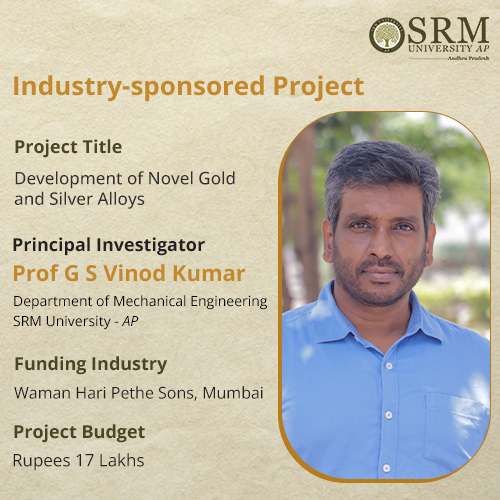
The research project titled Development of Novel Gold and Silver Alloys was sanctioned to Prof G S Vinod Kumar from the Department of Mechanical Engineering. The project was sanctioned by Waman Hari Pethe Sons, a leading Gold/Diamond jewellery manufacturing company based in Maharashtra, with a total outlay of Rupees 17 Lakhs. The tenure of the project is two years, from May 2022 to May 2024.
Prof Vinod Kumar’s research interests mainly revolve around the hardening of 22 carats and 24 carats gold for light-weight and high-strength jewellery and the novel processing of light alloy (Al and Mg) foam and studying the structure and properties. He has been intensely involved in the development of technologies for improving the hardness of 22k gold for weight saving and high strength in the cast and hand-made jewellery. This was jointly patented by SRM and Titan. He also has several industrial research partnerships and funded projects to his credit.
The present project aims to develop novel high carat gold (24,22 and 18 carats) for high-strength and light-weight jewellery applications and novel silver alloys (high pure (99%) or sterling silver (92.5%)) having better anti-tarnishing capability. It further aims to develop colour gold alloys (Black, violet and pink gold). The project also involves both the lab-scale and industrial development of the process for scaling up jewellery production of the gold and silver alloys.
- Fascinating overseas internship in Germany with SRM AP June 29, 2022
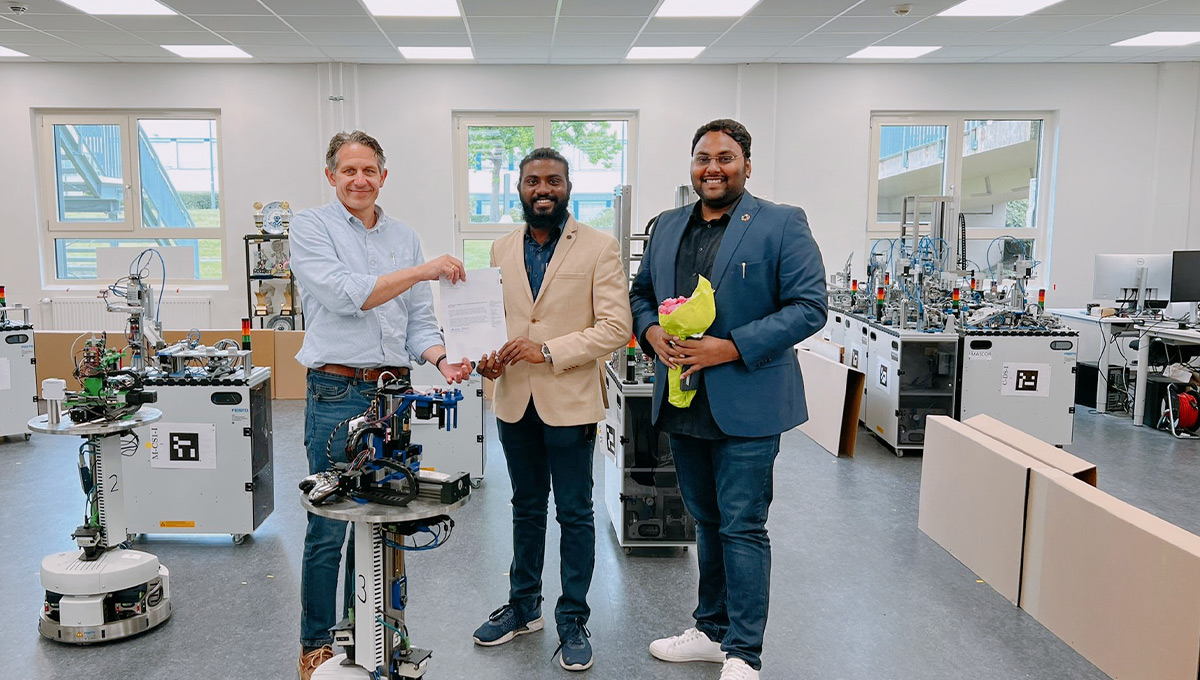 The results will be astonishing when hard work goes hand in hand with smart work. Vanteddu Nikhileswar from the Department of Mechanical Engineering at SRM University-AP preferred to believe in this strategy and has successfully completed an Internship and Project at MASCOR Institute in FH Aachen University, Germany.
The results will be astonishing when hard work goes hand in hand with smart work. Vanteddu Nikhileswar from the Department of Mechanical Engineering at SRM University-AP preferred to believe in this strategy and has successfully completed an Internship and Project at MASCOR Institute in FH Aachen University, Germany.Nikhileswar got the opportunity to do an Internship and the International Project Exchange Programme at Mobile Autonomous Systems and Cognitive Robotics Institute through Indo Euro Synchronization (IES), an organisation providing educational and research programmes beyond borders. Even though affected by the Covid-19 restrictions, he completed the project and internship that lasted 6 months with an excellent quality of work.
Expert guidance
Under the guidance of Dr Alexander Ferrein, Director of MASCOR Institute, Nikhileswar worked on his project “Webots Simulation of Spot Robot for Rescue League”. The project’s target was to create a bezier curve, find the inverse kinematics for spot Robot and Robot programming in ROS, and develop a webots simulation for the spot Robot and Quadruped gait to improve the motion capabilities in the webots simulation environment.
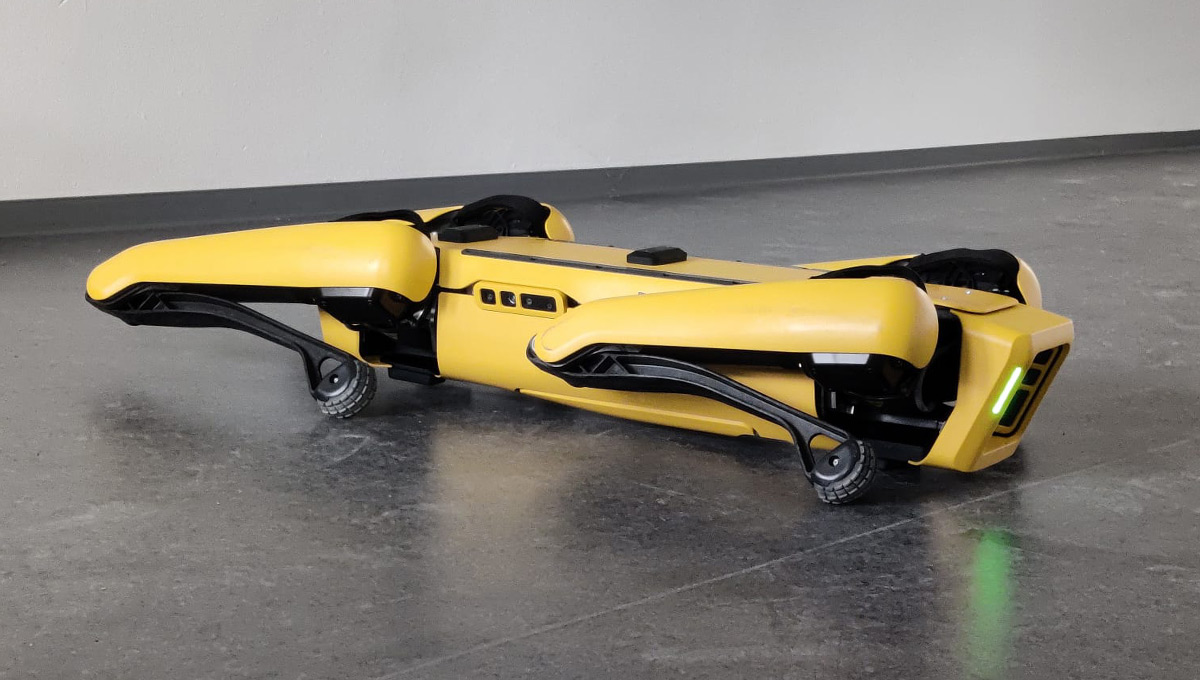
Priceless exposure
The skilled learning sessions with the scholars at the institute were a valuable addition to the career growth of Nikhileswar. While working in Germany, he was able to visit well-known companies and industries, which provided the opportunity to interact with many students and working professionals. This helped him to gain enormous clarity regarding different aspects of work opportunities and life as a whole.
Note of gratitude
He was thankful to the Indo Euro Synchronization President, Mr Venkat Raj, the management of SRM university-AP, Prof. Prakash Jadav, and Dr Pramod Jammy. The special guidance of Dr Starke, founder of MASCOR Institute, and Dr Alexander Ferrein, Director of MASCOR Institute FH Aachen University, holds a crucial role in his project work and internship.
Added accomplishment
Apart from the project, he has also secured admission at RWTH Aachen University for the Masters in Management and Engineering in Production Systems (MME-PS). This university ranks 147 Globally in QS Ranking 2023 and Ranks 19 QS World University Rankings by Subject 2022: Mechanical, Aeronautical & Manufacturing Engineering.
Continue reading → - Mechanical engineering students develop multi-utility buggy car June 17, 2022
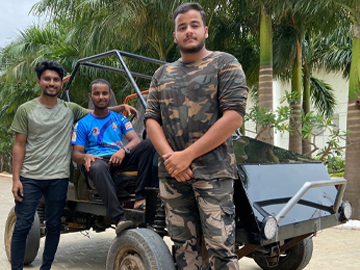 Stories of innovation from SRM AP are not something new! M Tanveer, G Sai Venkat, and Divyansh Awasthi, three vibrant students from the Department of Mechanical Engineering at SRM University-AP, have built a multi-utility buggy car as a part of their final year project work.
Stories of innovation from SRM AP are not something new! M Tanveer, G Sai Venkat, and Divyansh Awasthi, three vibrant students from the Department of Mechanical Engineering at SRM University-AP, have built a multi-utility buggy car as a part of their final year project work.The students initially planned to build a completely new multi-utility vehicle. Later they slightly modified the idea to make a buggy car from scrap materials, i.e. by gathering the efficiently working components from old and unused cars and making them compatible with the chassis.
Motivated by their admiration for the automotive industry, students had great enthusiasm for building the buggy car. They had an urge to convert theoretical knowledge gained from classrooms into practical working machines. Consequently, the trio developed an off-road diesel buggy to show their prowess in the automobile industry, especially on and off-road cars. A Diesel motor is utilised, which is competent in conveying a speed of 50 kilometres per hour.
The chassis of the buggy is designed and manufactured by the students themselves. The spare parts and connection are from the TATA ZIP car model and incorporated into the buggy fitting to the design. The necessary fitting and binding of spare parts are done according to the driving comfort.
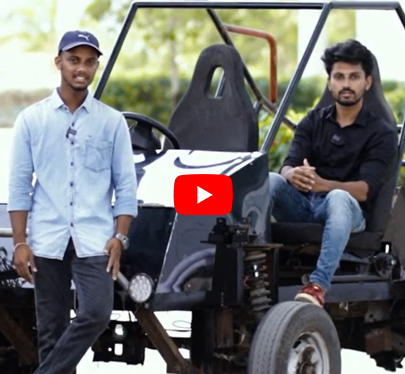
The students expressed their gratitude for the support of their project guide Dr Jasvinder Singh, co-guide Prof Venkata N Nori, and HOD Prof Prakash Jadhav. “We received constant mentorship and guidance throughout our project tenure from them”, said the students. “Whenever we were stuck or were not able to solve a particular problem, or at times were mentally stressed and worn out, our professors gave us proper guidance to warded off our problems and stress, ” they added.
Continue reading →

